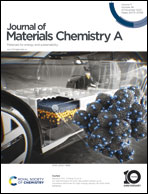Quad-metallic MOF-derived carbon-armored pseudo-high entropy alloys as a bifunctional electrocatalyst for alkaline water electrolysis at high current densities†
Abstract
A new catalyst design, pseudo-high entropy alloy (HEA), was proposed and demonstrated for high performance water electrolysis. Pseudo-HEAs, defined as single-phase four-element alloys of molar configurational entropy greater than 1.36R, are in general easier to design and prepare for enhanced electrocatalytic efficiency as compared with traditional HEAs of five or more elements. A carbon armored pseudo-HEA catalyst, FeCoNiMo@C, was synthesized with a simple two-stage thermal conversion of FeCoNiMo-MOF, grown in situ on a nickel foam (NF) substrate, to exhibit outstanding catalytic efficiency and stability toward water electrolysis in alkaline media. It delivered 10 and 500 mA cm−2 at ultra-low overpotentials of 55 and 233 mV, respectively for the hydrogen evolution reaction and 204 and 273 mV, respectively for the oxygen evolution reaction. The FeCoNiMo@C/NF//FeCoNiMo@C/NF couple achieved ultra-low cell voltages of 1.488 V@10 mA cm−2 and 1.725 V@500 mA cm−2 for full cell water splitting and ultra-stability at an industrially applicable high current density of 500 mA cm−2 with a minor decay of 3.4% over 50 h. The success was attributed to the atomic scale synergy between constituent atoms, Fe, Co, Ni and Mo, atomically dispersed in the pseudo-HEA.



 Please wait while we load your content...
Please wait while we load your content...